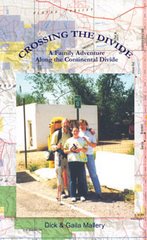Rodale sells backpacking magazine
Rodale Inc. of Emmaus sold its Backpacker Magazine to Active Interest Media Inc. for an undisclosed amount, the companies said today.
Active Media, of El Segundo, Calif., publishes enthusiast magazines and books, holds consumer shows, and operates Internet sites.
Backpacker, founded in 1973, has a circulation of 340,000 for its nine issues per year. The magazine provides information about backcountry adventure in North America and focuses on hiking trails, camping gear and survival tips.
"The sale of Backpacker will allow Rodale to focus its resources on long-term growth and further strengthen the position of its business and brands in the health, fitness, and wellness space," said Steven Pleshette Murphy, Rodale's president and chief executive.
Jonathan Dorn, Backpacker's editor-in-chief, will join Active Media, which has 13 magazines in the fields of healthy living, marine, homebuyer and Western art/living.
Rodale publishes health, fitness and wellness publications with a combined circulation of about 40 million monthly. It also is a book publisher and operates Internet sites.
Monday, May 28, 2007
Backpacking with kids
By Dan Vierra Sacramento Bee
Think it might be a major challenge to persuade your online kids to sample an on-trail adventure? Author Tim Hauserman makes it sound easy (and fun) in "Monsters in the Woods" (University of Nevada Press, $15.95, 137 pages). The monsters, of course, are the kids.With humor, Hauserman lays out strategies and advice for parents to help motivate kids to get out into the wild. The reward is a great time with Dad, so he says."To me, backpacking with my children is by far the best time I spend with them," Hauserman writes.He had no problem persuading his two daughters, although he learned what works best. Instead of taking both on a trip, he prefers bringing one and her friend. He also invites the friend’s father.What do I pack? Can I take the dog? Is an infant too young to take backpacking? All these are addressed in this comprehensive how-to of family adventures.Hauserman, who lives in northern California, also wrote "The Tahoe Rim Trail: A Complete Guide for Hikers, Mountain Bikers, and Equestrians" (Wilderness Press, $15.95, 160 pages). He knows his backpacking trails and has great hopes for the younger, high-tech generation.During a field trip to Mono Lake with one daughter, an American Indian medicine man related to the school group how he had been taught to appreciate nature as a child and how he learned to be "part of the river" while fishing."Will our children ever learn that level of appreciation for nature?" Hauserman writes. "Probably not, but if we can help them learn to love nature and understand it, we will be doing them and the planet a great service."
Think it might be a major challenge to persuade your online kids to sample an on-trail adventure? Author Tim Hauserman makes it sound easy (and fun) in "Monsters in the Woods" (University of Nevada Press, $15.95, 137 pages). The monsters, of course, are the kids.With humor, Hauserman lays out strategies and advice for parents to help motivate kids to get out into the wild. The reward is a great time with Dad, so he says."To me, backpacking with my children is by far the best time I spend with them," Hauserman writes.He had no problem persuading his two daughters, although he learned what works best. Instead of taking both on a trip, he prefers bringing one and her friend. He also invites the friend’s father.What do I pack? Can I take the dog? Is an infant too young to take backpacking? All these are addressed in this comprehensive how-to of family adventures.Hauserman, who lives in northern California, also wrote "The Tahoe Rim Trail: A Complete Guide for Hikers, Mountain Bikers, and Equestrians" (Wilderness Press, $15.95, 160 pages). He knows his backpacking trails and has great hopes for the younger, high-tech generation.During a field trip to Mono Lake with one daughter, an American Indian medicine man related to the school group how he had been taught to appreciate nature as a child and how he learned to be "part of the river" while fishing."Will our children ever learn that level of appreciation for nature?" Hauserman writes. "Probably not, but if we can help them learn to love nature and understand it, we will be doing them and the planet a great service."
Backpacking 101--Women on the Trail
ANNE CHALFANT: TICKET TO RIDE
Enthusiastic hiker definitely walks the walks
I STEPPED INTO Peet’s Coffee and Tea looking for a tanned woman — a serious hiker I was about to interview. I was sure she would be decked out in multipocketed khaki pants. After all, Susan Alcorn, of Oakland, spends her time tromping trails — and right after our interview was heading for an overnight backpack trip on Sunol’s Ohlone Trail.
But the woman who answered to my "Susan?" was dressed in black slacks and a black-and-white checked jacket, looking like a schoolteacher.
Alcorn had in fact been a elementary schoolteacher in Hercules in the 1990s. But following her divorce, she expanded her interest in hiking, taking the sport up at age 48 with Sierra Club-sponsored hikes.
One good thing led to another — in this case a new husband whom she met on one of those outdoor outings. Ralph Alcorn, who had grown up in Yellowstone National Park, was game to go along with Susan’s yearning to expand their hiking to backpacking. That led the couple eventually to a trek to the top of Africa’s 19,335-foot Mount Kilimanjaro. The Alcorns have also hiked the famous pilgrimage trail, Santiago de Compostela, in Spain and have covered most of the Pacific Crest Trail, which stretches from Canada to Mexico.
Susan Alcorn is now 66 and Ralph Alcorn is 71.
Keep on hikin’
So what makes the Alcorns keep on hiking these days?
All the usual "because it’s there" reasons apply.
But Susan Alcorn also notes how empowering it is for women to feel the self-sufficiency of
making their way in the wilderness. That’s a theme Alcorn explored in an earlier book, "We’re in the Mountains, Not Over the Hill" — a book of essays by backpacking women, which Alcorn edited and self-published under her imprint Shepherd Canyon Press.
The Alcorns also hike because, "You can go places you couldn’t go otherwise," Susan notes. To practice for their longer outings, they prowl the trails of East Bay Regional Parks, of which Susan says, "We’re so lucky here."
Fingers do the walking
Alcorn also hikes so she can write about it. Her book "Camino Chronicle: Walking to Santiago" (Shepherd Canyon, $14.95) is a finalist for the prestigious Benjamin Franklin Award, sponsored by the Independent Book Publishers Association. The book chronicles the Alcorns’ experience along the trail, and outlines the history of the ancient pilgrimage route. The trail was a newsmaker when the likes of Charlemagne walked it, and it continues to attract thousands of pilgrims still today, including actress Shirley MacLaine and presidential daughter Jenna Bush. The trail leads to Compostela de Santiago, where the bones of the apostle St. James are in the crypt.
Villagers along the trail, Alcorn notes, are very supportive of hikers. The same holds true for Pacific Crest Trail hikers in the United States along which "trail angels" drop food and water, or answer Internet postings to drive hikers 100 miles to the trail.
Heavy on the shoulders
The difficulty of carrying enough food and water is a big issue for backpackers. At one point on the PCT the Alcorns went 10 days before refueling. Yet Susan — whose shoulders are slight — is only comfortable carrying a 25-pound pack. That’s not a lot when you think of food, water, cooking utensils, medical supplies and a sleeping bag. Ralph picks up the slack with their sleeping tarp and extra food and water.
I must say, I have yet to meet the woman who loves shouldering a backpack, so it impresses me to talk to one who is even willing.
So what does Alcorn miss the most when she’s out tromping the wilderness?
"Salads and showers," she said promptly.
And the most unexpected thing you will find in her pack?
"An umbrella." She goes on to describe a lightweight version that gets them through both rainstorms and brain-frying heat, such as what they found on the Mojave desert.
And what does the Montclair woman do to survive those many sweaty days with no showers?
"Baby wipes," she said.
Anne Chalfant is a travel editor.
Enthusiastic hiker definitely walks the walks
I STEPPED INTO Peet’s Coffee and Tea looking for a tanned woman — a serious hiker I was about to interview. I was sure she would be decked out in multipocketed khaki pants. After all, Susan Alcorn, of Oakland, spends her time tromping trails — and right after our interview was heading for an overnight backpack trip on Sunol’s Ohlone Trail.
But the woman who answered to my "Susan?" was dressed in black slacks and a black-and-white checked jacket, looking like a schoolteacher.
Alcorn had in fact been a elementary schoolteacher in Hercules in the 1990s. But following her divorce, she expanded her interest in hiking, taking the sport up at age 48 with Sierra Club-sponsored hikes.
One good thing led to another — in this case a new husband whom she met on one of those outdoor outings. Ralph Alcorn, who had grown up in Yellowstone National Park, was game to go along with Susan’s yearning to expand their hiking to backpacking. That led the couple eventually to a trek to the top of Africa’s 19,335-foot Mount Kilimanjaro. The Alcorns have also hiked the famous pilgrimage trail, Santiago de Compostela, in Spain and have covered most of the Pacific Crest Trail, which stretches from Canada to Mexico.
Susan Alcorn is now 66 and Ralph Alcorn is 71.
Keep on hikin’
So what makes the Alcorns keep on hiking these days?
All the usual "because it’s there" reasons apply.
But Susan Alcorn also notes how empowering it is for women to feel the self-sufficiency of
making their way in the wilderness. That’s a theme Alcorn explored in an earlier book, "We’re in the Mountains, Not Over the Hill" — a book of essays by backpacking women, which Alcorn edited and self-published under her imprint Shepherd Canyon Press.
The Alcorns also hike because, "You can go places you couldn’t go otherwise," Susan notes. To practice for their longer outings, they prowl the trails of East Bay Regional Parks, of which Susan says, "We’re so lucky here."
Fingers do the walking
Alcorn also hikes so she can write about it. Her book "Camino Chronicle: Walking to Santiago" (Shepherd Canyon, $14.95) is a finalist for the prestigious Benjamin Franklin Award, sponsored by the Independent Book Publishers Association. The book chronicles the Alcorns’ experience along the trail, and outlines the history of the ancient pilgrimage route. The trail was a newsmaker when the likes of Charlemagne walked it, and it continues to attract thousands of pilgrims still today, including actress Shirley MacLaine and presidential daughter Jenna Bush. The trail leads to Compostela de Santiago, where the bones of the apostle St. James are in the crypt.
Villagers along the trail, Alcorn notes, are very supportive of hikers. The same holds true for Pacific Crest Trail hikers in the United States along which "trail angels" drop food and water, or answer Internet postings to drive hikers 100 miles to the trail.
Heavy on the shoulders
The difficulty of carrying enough food and water is a big issue for backpackers. At one point on the PCT the Alcorns went 10 days before refueling. Yet Susan — whose shoulders are slight — is only comfortable carrying a 25-pound pack. That’s not a lot when you think of food, water, cooking utensils, medical supplies and a sleeping bag. Ralph picks up the slack with their sleeping tarp and extra food and water.
I must say, I have yet to meet the woman who loves shouldering a backpack, so it impresses me to talk to one who is even willing.
So what does Alcorn miss the most when she’s out tromping the wilderness?
"Salads and showers," she said promptly.
And the most unexpected thing you will find in her pack?
"An umbrella." She goes on to describe a lightweight version that gets them through both rainstorms and brain-frying heat, such as what they found on the Mojave desert.
And what does the Montclair woman do to survive those many sweaty days with no showers?
"Baby wipes," she said.
Anne Chalfant is a travel editor.
Wednesday, May 9, 2007
Backpacking 101--Physicist Gives Advice
No car, no house, no electricity, no job — it’s a liberating feeling.
Hiking, backpacking and mountain climbing improve your fitness level. We humans are animals, and as such, we have muscles to use. A host of diseases affect those who do not use those muscles.
When you backpack, you can eat like a pig and still lose weight. I started out with a 65-pound pack when my wife and I backpacked the Wonderland Trail around Mt. Rainier. When we finished 10 days later, we were down to our last few peanuts and raisins, and my pack weighed about 40 pounds. We each lost five pounds in body weight.
When you die, you cannot bring money or material goods with you. You carry forth only memories of your experiences. The struggles I’ve put my body through, whether it’s climbing a mountain or trudging to a campsite after a long day of backpacking, have exalted my spirit and imprinted lifelong memories.
One such memory is from my Mt. Rainier climb. We left Camp Muir (elevation 10,000 feet) at about 3:30 on an August morning, climbing in the dark over Cowlitz Glacier, Cathedral Rocks and then Ingraham Glacier. Taking a break, we saw the sun rise over Little Tahoma. It was like watching the world being born below us, the day coming alive in the cycle of death and rebirth.
True, there are tribulations, such as no plumbed toilets in the backcountry (one exception is Bright Angel Campground in the Grand Canyon). Answering nature’s call can be a mini-adventure in itself.
Nature is not a benign environment. Weather and predators can kill. Cougars have been known to stalk humans. It’s a good idea to carry a folding or sheathed knife with at least a four-inch blade. The folding knife must be capable of opening with a snap of the wrist. One survivor on Vancouver Island suffered bites to his neck because he needed both hands to open his knife to kill the cougar that was attacking him.
Be receptive to your experiences outdoors.
From the interior of the inland forests, Highway 101 southbound on the Olympic Peninsula suddenly bursts into the gray-white expanse of the Pacific at Ruby Beach. It is like coming out of a tunnel, or coming out of the womb. The trees have given way to the cathedral ceiling of sky. Now there is more light — a flat, gray light that reflects off the clouds, the gray-green ocean and the gray sand. The quiet of the forest has given way to winter’s thunderous clap of surf, a surge-and-give that rolls over sand and driftwood, eating away at the coast to leave behind sea stacks — hard rock islands of the previous shoreline.
Such moments are little epiphanies. As a physicist-turned-writer, I find that they occur more and more for me in the natural world, on that edge of experience where the mind is alert with the possibilities of remembrance. The moments pass quickly enough, but I’ve learned to recognize them.
Go out and recognize yours.
Hiking, backpacking and mountain climbing improve your fitness level. We humans are animals, and as such, we have muscles to use. A host of diseases affect those who do not use those muscles.
When you backpack, you can eat like a pig and still lose weight. I started out with a 65-pound pack when my wife and I backpacked the Wonderland Trail around Mt. Rainier. When we finished 10 days later, we were down to our last few peanuts and raisins, and my pack weighed about 40 pounds. We each lost five pounds in body weight.
When you die, you cannot bring money or material goods with you. You carry forth only memories of your experiences. The struggles I’ve put my body through, whether it’s climbing a mountain or trudging to a campsite after a long day of backpacking, have exalted my spirit and imprinted lifelong memories.
One such memory is from my Mt. Rainier climb. We left Camp Muir (elevation 10,000 feet) at about 3:30 on an August morning, climbing in the dark over Cowlitz Glacier, Cathedral Rocks and then Ingraham Glacier. Taking a break, we saw the sun rise over Little Tahoma. It was like watching the world being born below us, the day coming alive in the cycle of death and rebirth.
True, there are tribulations, such as no plumbed toilets in the backcountry (one exception is Bright Angel Campground in the Grand Canyon). Answering nature’s call can be a mini-adventure in itself.
Nature is not a benign environment. Weather and predators can kill. Cougars have been known to stalk humans. It’s a good idea to carry a folding or sheathed knife with at least a four-inch blade. The folding knife must be capable of opening with a snap of the wrist. One survivor on Vancouver Island suffered bites to his neck because he needed both hands to open his knife to kill the cougar that was attacking him.
Be receptive to your experiences outdoors.
From the interior of the inland forests, Highway 101 southbound on the Olympic Peninsula suddenly bursts into the gray-white expanse of the Pacific at Ruby Beach. It is like coming out of a tunnel, or coming out of the womb. The trees have given way to the cathedral ceiling of sky. Now there is more light — a flat, gray light that reflects off the clouds, the gray-green ocean and the gray sand. The quiet of the forest has given way to winter’s thunderous clap of surf, a surge-and-give that rolls over sand and driftwood, eating away at the coast to leave behind sea stacks — hard rock islands of the previous shoreline.
Such moments are little epiphanies. As a physicist-turned-writer, I find that they occur more and more for me in the natural world, on that edge of experience where the mind is alert with the possibilities of remembrance. The moments pass quickly enough, but I’ve learned to recognize them.
Go out and recognize yours.
Subscribe to:
Posts (Atom)








